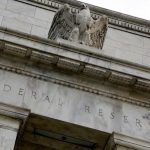
(Reuters) – Investor optimism that the Federal Reserve will start cutting interest rates is breathing new life into the market for junk debt, providing timely relief to the lowest-rated companies and likely capping the rate of defaults in 2024.
As the U.S. central bank started to raise rates in 2022 and worries about defaults grew, companies rated below investment grade saw tepid demand from investors for their loans and bonds.
Many such companies turned to roundabout ways to raise money to get ahead of a $300 billion wall of bond and loan maturities in the next two years.
In the last few months, however, yields have fallen as investors bet the Fed, emboldened by its progress in slowing a surge in prices that pushed inflation to 40-year highs last year, will soon start cutting rates.
Markets are now pricing the U.S. central bank’s key policy rate to fall as much as 1.5 percentage points below the current 5.25%-5.50% range by the end of next year.
Expectations of such a pivot have led to a resurgence in demand for high-yielding debt.
Junk bond spreads, or the premium investors charge over U.S. Treasuries for taking on the risk, have on average tightened 38 basis points since September to 343 basis points, the lowest level since April 5, 2022, according to the ICE BAML index.
In December, insurance brokerage USI Inc, a company rated deep in the junk territory, became the first borrower in its category to tap the primary markets since April, according to data provider Informa Global Markets.
“While it is possible defaults may increase slightly toward historical averages, a lot of this appears to be priced into the market today,” said Manuel Hayes, senior portfolio manager at Insight Investment.
Estimates vary, but analysts expect junk bond default rates to top out at 4% to 5% this year, compared with 2% to 3% in 2023 and far lower than the double-digit readings touched during the 2008 financial crisis.
Default rates on leveraged loans, whose interest rates are not fixed but change with the market, are expected to tick up to 5%-6%.
One reason for the relatively low rates of default is that some companies have been deploying creative ways to tap financing markets, which has given them the breathing room to meet their debt obligations.
These include distressed exchanges, where investors agree to get paid less than what they were entitled to in exchange for new or restructured debt secured by collateral.
They also have been extending the maturity on old debt by agreeing to more restrictive terms on new debt, and putting up collateral or equity to raise money from direct lenders and other private credit providers.
A more involved strategy is to raise debt through a local or foreign subsidiary from new and existing lenders, with the proceeds then sent back to the parent company to buy its maturing debt at a discount.
The strategy, part of liability management exercises, raises the risk of legal disputes, as it increases some creditors’ claims on assets during bankruptcy by diluting others.
“Distressed exchanges are on the rise, as are the use of creative debt-raising solutions, as less creditworthy companies look to raise liquidity to live now to fight another day,” said Glenn Reynolds, the founder of Macro4Micro, a research firm.
MIX OF REACTIONS
Some analysts said many risks remain. A default cycle may become unavoidable if the Fed surprises markets and doesn’t cut rates as aggressively or as soon as people think. And the use of creative financing strategies may only go so far.
“Even if investors participate in such creative trades, whether they would have a higher claim on the company’s assets during bankruptcy is still untested in courts,” said Ian Walker, head of legal innovation at Covenant Review, a research firm.
Creditors are already becoming more wary. “A lot of our clients are starting to consider putting protections in credit documentation to make sure that they don’t get short-changed by these liability management transactions,” said Jason Ewart, a partner in the global financial markets team at Clifford Chance, a law firm.
“It is a mix of investor reactions, with some supporting the need for such trades as a temporary liquidity measure while others are simply keen to close such loopholes,” Ewart said.
More than $190 billion of the debt maturing in 2024-2025 belongs to the lowest-rated high-yield companies, according to CreditSights.
“We could push right up against it but may not entirely get a full-fledged default cycle,” said Meghan Robson, the head of U.S. credit strategy at BNP Paribas (OTC:BNPQY).
To read the full article, Click Here

